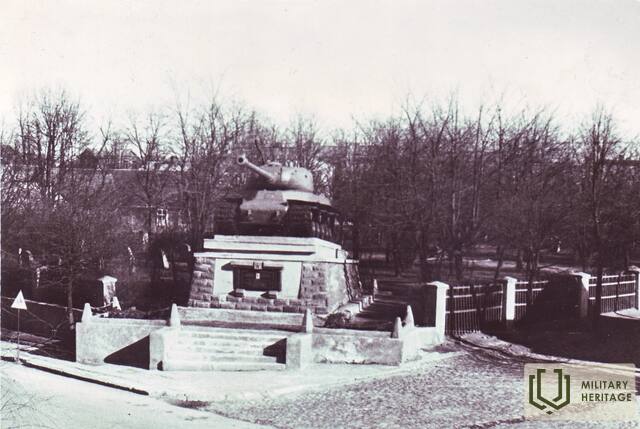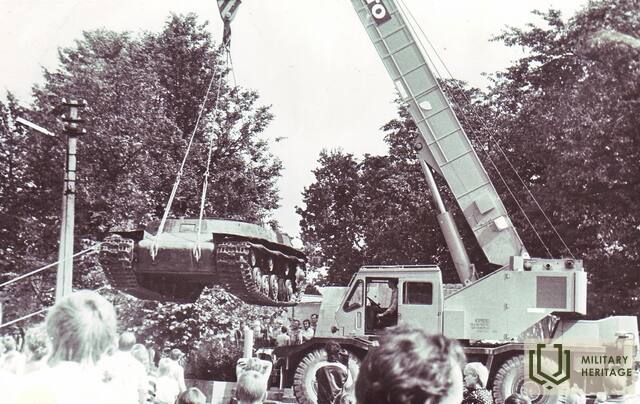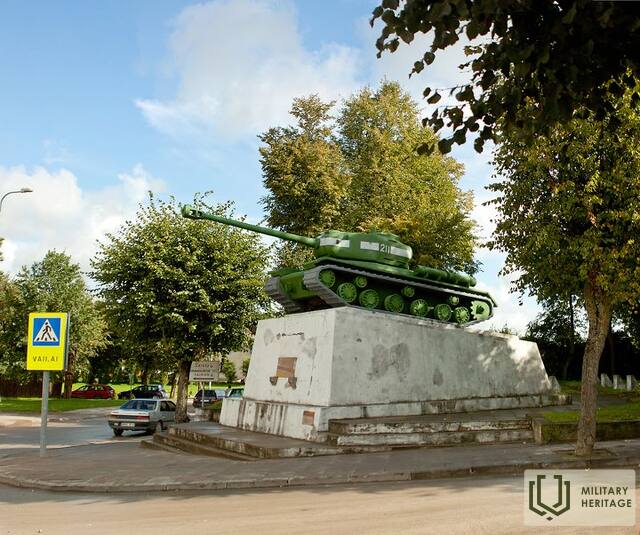Salantai tank

The story of the Soviet heavy tank IS-2 in Salantai is told from the events of World War II to its becoming an element of the Soviet memorial and part of the artistic space (Orvidai Homestead-Museum).
Visitors to the Orvidai Farmhouse-Museum are greeted by the IS-2 (ИС-2) tank. These Soviet-made tanks appeared in 1944. They are classified as heavy tanks (weighing 46 tons) and are considered the most powerful and heavily armored Soviet tank of World War II. It was the Soviet response to the German Tiger I. It is said that these tanks played a major role in the battles of 1944–1945, especially in storming cities. The IS-2 was used by the forces of the Soviet Union and the Russian Federation until 1993. One of them, as an exhibit, can be seen in Lithuania today.
In 1944, the burial of Soviet soldiers began on the outskirts of the Salantai town market square. In 1944–1945, the remains of soldiers from all over Salantai parish were brought here, and the remains of soldiers from Courland were also brought. The tank crew commander, Guard Junior Lieutenant Georgijus Tyrinas (born 1918), was also buried in Salantai. In 1939–1940, Tyrinas participated in the Soviet invasion of Finland (Winter War), and from June 1941 – in World War II. In 1944, he was awarded the title of Hero of the Soviet Union for his courage and heroism in battles during the crossing of the Dnieper and the defense of the Guard bridgehead. On October 16, 1944, Tyrinas died in battle in Lithuania. It is with this soldier that the appearance of the tank monument in Salantai is also associated.
In honor of the Hero of the Soviet Union Tyrin, a monument with a tank was erected in 1947 at the Salantai Soviet Union Soldiers' Cemetery. Although literature mentions that Tyrin commanded the Soviet-made heavy tank KV (КВ; manufactured 1939–1942) or the British-made Mk.IV (A22) "Churchill" (1941–1945; entered the Soviet Union under the Lend-Lease program), the IS-2 is located in the cemetery. It is said about the latter tank that during the war in Salantai it ran over a mine and exploded. Only the "shell" of the tank was used for the monument, as the internal equipment was destroyed by the explosion. The central square of the Salantai city was also named after Tyrin. The monument quickly became part of the daily life of Salantai: it became a place for people to meet and date, and a frequent place for taking photos. International Workers' Day (May 1) and other holidays were celebrated near it.
The tank stood like this for more than 40 years. Its further history developed during the days of the August Putsch. Only after the unsuccessful putsch, on August 24, 1991, did the Salantai City Municipal Council adopt a decision allowing artist Vilis Orvidas to remove the tank and transport it to his homestead. There was a condition that the tank would remain the property of the municipality. And so it happened, Orvidas transported the tank to his famous homestead near Salantai, known today as the Orvidas Homestead-Museum. The people of Salantai recall that it was not possible to remove the tank from its pedestal in one go, even with a powerful Japanese crane, so it was removed and transported to the homestead in parts. The children creatively “deciphered” the name of the KATO crane that removed the tank – “Kuda Otpravil Tank Orvidas”.
On September 9, 2011, a sculpture called “Tank” appeared on the pedestal where the tank had previously stood – a replica of the IS-2 tank created by artist Juozas Laivis. The tank, one might say, returned to Salanty, at least for a short time. According to project coordinator Tomas Danilevičius, this provocative artistic action was intended “for the residents of the town and to encourage their creativity”. This action was part of the artistic project “Mobile Sculptures”.
- Audronė Griežienė, "The people of Salantiškiai will not give up the tank", in: Pajūrio naujienos, 2020-06-16, available online: https://www.pajurionaujienos.com/index.php?sid=20176&act=exp .
- "Salantų Soviet Soldiers' Cemetery", in: Lithuanian Integral Museum Information System, available online: https://www.limis.lt/valuables/e/805661/570182068?digitalObjectId=570182089 .
- "Tank returns to Salantus", in: artnews.lt, 2011-09-07, available online: https://artnews.lt/tankas-grizta-i-salantus-12398.
- Paulius Vaniukhinas, “Salantų Tank and the Cemetery of Soviet Army Soldiers”, in: From Skilandži to Salantai… Salantai. The Past of the Hometown, 2012-11-07, available online: https://salantiskis.blogspot.com/2012/11/salantu-tankas-ir-tarybiniu-kariu.html .
- Сергей Каргаполцев (trans.), "Тырин Георгий Михайлович", in: Герои страны. Международный патиротический интернет-проект, online access: https://www.warheroes.ru/hero/hero.asp?Hero_id=5788 .









